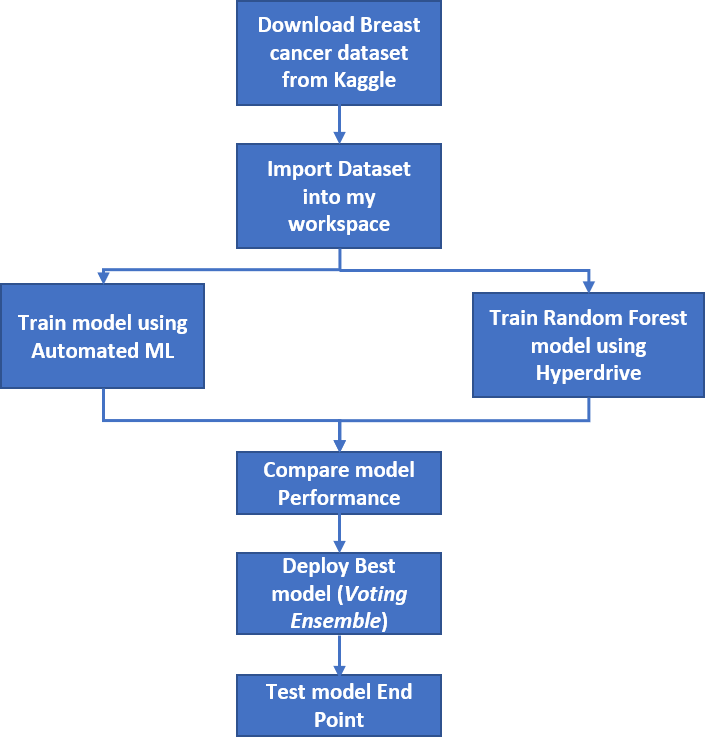Predict whether the cancer is benign or malignant using Azure Machine learning service. We compare the results of Azure automated machine learning and Hyperparameter tuning to solve this classification problem. Then we deploy the model on an Azure Container Serivce(ACI) as a respoint endpoint and test the endpoing by consuming it using an HTTP post request and get a prediction.
We used the Breast Cancer Wisconsin (Diagnostic) Data Set.Features are computed from a digitized image of a fine needle aspirate (FNA) of a breast mass. They describe characteristics of the cell nuclei present in the image. Dataset was download from Kaggle : breast-cancer-wisconsin-data Also can be found on UCI Machine Learning Repository
We approach the project as a classification task. We wanted to classiy the cancer as benign or malignant based on the provided data. The target column is Diagnosis (M = malignant, B = benign).
To access the data in my workspace i had to import the the csv file as a dataframe, do some cleaning, save the the as a csv before uploading in the datastore for it to be accessible via as a Tabular Dataset.
ds_tr = ws.get_default_datastore()
ds = Dataset.Tabular.from_delimited_files(path=ds_tr.path('cancerdata2/cancer_train_data.csv'))
For the AutoML experiment we have the following key settings. Most of them were set to limit the compute time and cost.
- Limit the number of iterations to 20
- Time limit fo experimentation is 20 minutes
- iteration should time ou in 10 minutes
- We enable early stopping
- Use a 5 fold cross validation
- Limit the number of concurrent iteration to 3
- We enable featurization as we wanted AutoML to also evaludate different feature engineering of our numerical features
automl_settings = {
"name": "udacity_AutoML_BreastCancer_{0}".format(time.time()),
'iterations':20,
"experiment_timeout_minutes" : 20,
"enable_early_stopping" : True,
"iteration_timeout_minutes": 10,
"n_cross_validations": 5,
"primary_metric": 'AUC_weighted',
"max_concurrent_iterations": 3,
'featurization': 'auto'
}
automl_config = AutoMLConfig(task='classification',
compute_target=gpu_cluster,
training_data = training_data,
label_column_name = 'diagnosis',
run_configuration = conda_run_config,
**automl_settings,
)
The best model from Auto ML is a VotingEnsemble with an AUC Weighted score of 0.9950.
The AutoML Run details, the best model is the VotingEnsemble , followed by StackEnsemble and LightGBM. In practice the gap
between the performance of top 5 models is very negligible (expert for ML competition).
The best AutoML model parameters.
For this experiment we used a Random Forest ,which we fine tuned using Grid Sampling for the following hyperparameter : max_depth, max_features,min_sample_leaf,n_estimators.
ps = GridParameterSampling({
"--max_depth":choice(3,6,12,20),
"--max_features":choice('auto','sqrt','log2'),
"--min_samples_leaf":choice(1,3,5),
"--n_estimator":choice(20,40,100,1000)
})
# Specify a Policy
policy = BanditPolicy(slack_factor = 0.1, evaluation_interval=1, delay_evaluation=5)
estimator = ScriptRunConfig(source_directory='./scripts',
script='train.py',
compute_target=gpu_cluster,
environment=keras_env)
# Create a HyperDriveConfig using the estimator, hyperparameter sampler, and policy.
hyperdrive_config = HyperDriveConfig(run_config= estimator,
hyperparameter_sampling=ps,
policy=policy,
primary_metric_name="accuracy",
primary_metric_goal=PrimaryMetricGoal.MAXIMIZE,
max_total_runs=50,
max_concurrent_runs=4,
max_duration_minutes= 20)
With our Hyperparemeter configuration settings and search space we obtained 0.965 accuracy with the Random Forest with a max_depth of 12, 20 estimators, max_features auto and min_sample_leaf of 1. We could have improved that results by increasing the max_duration_minutes which would allow Hyperdrive to explore
more space in the Grid. Also doing feature engineering in this case could have improved the results.
Best Hyperdrive model
Based on those results we have deployed and test the best automl. To do so :
-
Get the best model from the training run
from azureml.train.automl.run import AutoMLRun run_id = 'AutoML_0bcb2574-d48f-4b5c-9afa-e7dae19237fc_18' automl_training_run = AutoMLRun(exp,run_id) automl_training_run -
Regsiter the model
description = 'Breast Cancer Classification' model = automl_run.register_model(model_name = model_name,description= description,tags =None) -
Download the score python file from azure ml
-
Create an inference configuration
-
Create an ACI deployment configuration
-
Deploy the model
from azureml.core.environment import Environment from azureml.core.webservice import AciWebservice,Webservice from azureml.core.model import Model,InferenceConfig aci_service_name = 'breast-cancer-classifier' inference_config = InferenceConfig(entry_script = script_filename, environment = best_run.get_environment()) aciconfig = AciWebservice.deploy_configuration(cpu_cores=1, memory_gb=1, tags={'type':"breast-cancer-classification"}, description='Udacity project Breast cancer classification') aciservice = Model.deploy(workspace=ws, name=aci_service_name, models=[model], inference_config=inference_config, deployment_config=aciconfig) aciservice.wait_for_deployment(show_output=True)
To consume the model
-
We copy the rest endpoint
-
Create a sample JSON payload
test_sample = {"data" : [{"radius_mean":17.99, "texture_mean":10.38, "perimeter_mean":122.8, "area_mean":1001.0, "smoothness_mean":0.1184, "compactness_mean":0.2776, "concavity_mean":0.3001, "concave points_mean":0.1471, "symmetry_mean":0.2419, "fractal_dimension_mean":0.07871, "radius_se":1.095, "texture_se":0.9053, "perimeter_se":8.589, "area_se":153.4, "smoothness_se":0.006399, "compactness_se":0.04904, "concavity_se":0.05373, "concave points_se":0.01587, "symmetry_se":0.03003, "fractal_dimension_se":0.006193, "radius_worst":25.38, "texture_worst":17.33, "perimeter_worst":184.6, "area_worst":2019.0, "smoothness_worst":0.1622, "compactness_worst":0.6656, "concavity_worst":0.7119, "concave points_worst":0.2654, "symmetry_worst":0.4601, "fractal_dimension_worst":0.1189}]} -
Post the payload to the endpoint using a HTTP Post
import requests import json scoring_uri = 'http://85c4a414-e90c-4838-84ba-d7aa5295a446.eastus.azurecontainer.io/score' # Convert to JSON string input_data = json.dumps(test_sample) # Set the content type headers = {'Content-Type': 'application/json'} # Make the request and display the response resp = requests.post(scoring_uri, input_data, headers=headers) print(resp.json())
See below the registered model and endpoint screen
Next steps would be to investigate the Voting Ensemble and Hyperparameters to see how we could improve performance. Also we could extend the project into more MLOps by adding source version control to the code and create a DevOps pipeline to kick our ML pipeline for training,testing and deployment.
